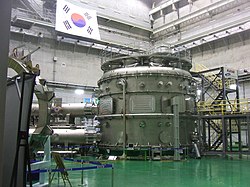| Korea Superconducting Tokamak Advanced Research | |
|---|---|
 | |
| Device type | Tokamak |
| Location | Daejeon, South Korea |
| Affiliation | Korea Institute of Fusion Energy |
| Technical specifications | |
| Major radius | 1.8 m (5 ft 11 in) |
| Minor radius | 0.5 m (1 ft 8 in) |
| Magnetic field | 3.5 T (35,000 G) |
| Heating power | 14 MW |
| Plasma current | 2 MA |
| History | |
| Date(s) of construction | 14 September 2007 |
| Year(s) of operation | 2008–present |
The KSTAR (or Korea Superconducting Tokamak Advanced Research; Korean: 초전도 핵융합연구장치, literally "superconductive nuclear fusion research device")[1] is a magnetic fusion device at the Korea Institute of Fusion Energy in Daejeon, South Korea. It is intended to study aspects of magnetic fusion energy that will be pertinent to the ITER fusion project as part of that country's contribution to the ITER effort. The project was approved in 1995, but construction was delayed by the East Asian financial crisis, which weakened the South Korean economy considerably; however, the project's construction phase was completed on September 14, 2007. The first plasma was achieved in June 2008.[2][3]
- ^ "KSTAR | 국가핵융합연구소". www.nfri.re.kr (in Korean). Archived from the original on 2020-08-10. Retrieved 2020-06-20.
- ^ "www.knfp.net". October 23, 2015. Archived from the original on 2015-10-23.
- ^ "KSTAR celebrates first plasma". ITER. Retrieved 2018-09-18.